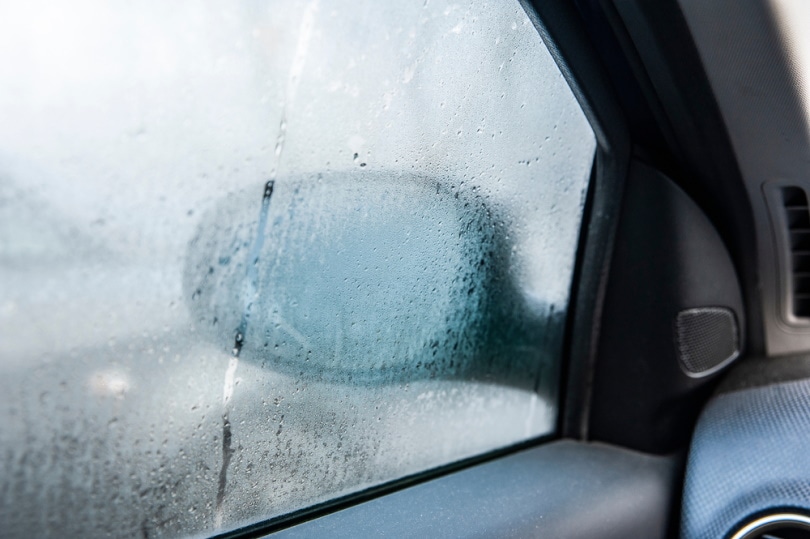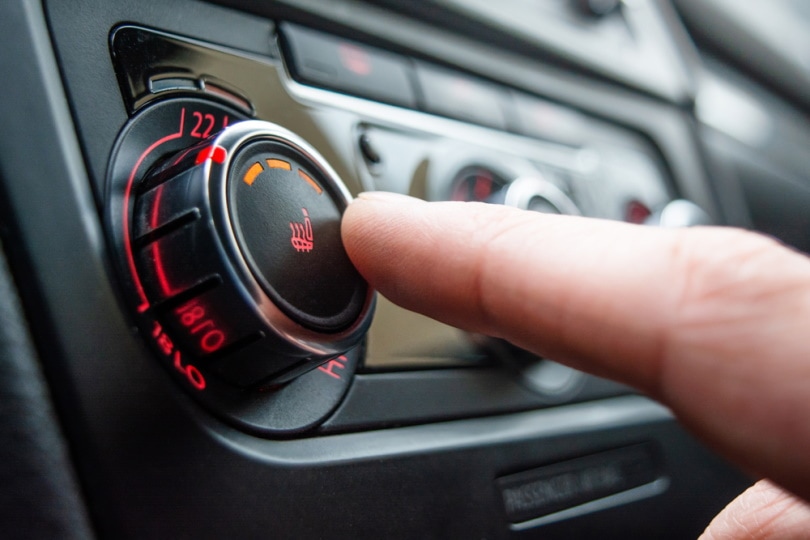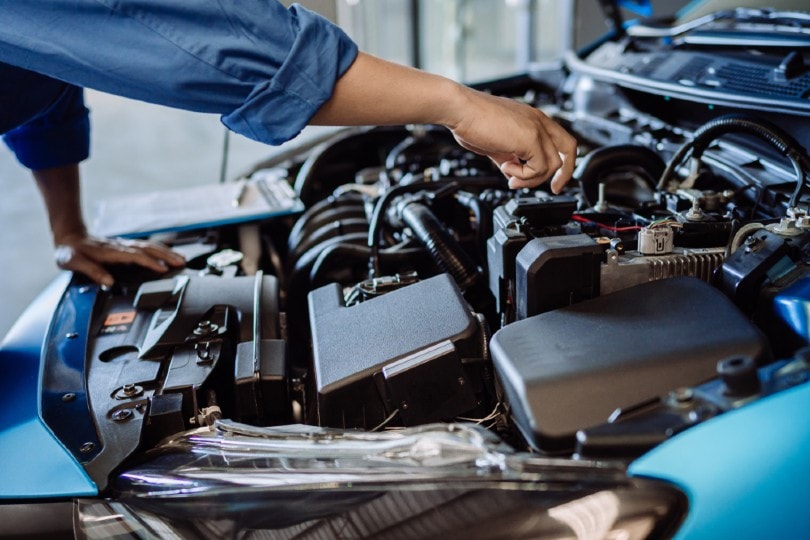How to Get Rid of Condensation on the Inside of Car Windows? 3 Ways

When you’re driving down the road, you need to be able to see around you, but when the weather is at one extreme or another, condensation can start to form and block your view. It’s only a matter of time before you must deal with it, so knowing what to do before the problem strikes is critical.
Here, we highlighted a few different ways to clear up your windows, along with a few potential causes if you’re finding more condensation on the inside of your windows than you should.

The 3 Ways on How to Get Rid of Condensation Inside Car Windows
If you’re finding condensation on the inside of your car window or windshield, you have a few different options to clear it up.
1. The Fastest Way

When you need your windows cleared fast and it’s cold outside, it’s time to start playing with the heater dial. Start by cranking the heat up to its highest setting. Hot air holds more moisture, so it will help grab all the moisture off the windows.
Next, turn on the A/C. This will pull the air from the car and push it through the cooling coils in the air conditioner. Turn off the recirculation button so you get outside air, and crack the windows open for a few minutes.
You might get a little cold, but it will clear up that moisture problem in no time!
2. When You Want to Stay Warm
Nobody wants to crank on the air conditioner when it’s freezing outside. While it might be the fastest way to get rid of condensation inside your car, it’s not the most comfortable. Try this method instead. Turn off the recirculation function on the heater, and turn the defroster to full blast. This will grab the air off the windshield and pull it outside while dragging fresh, drier air in.
3. Soaking It Up

The easiest way is to grab a towel and soak it all up. Just be sure to remove the towel from your vehicle afterward.
If not, the moisture will stay inside the car, and the next time that conditions are right, you’ll find moisture back on your windshield. You can leave a fresh towel in your car, though; just swap it out after you use it!
Causes of Condensation on the Inside of Car Windows
There can be many potential causes of condensation on the inside of car windows. While simply breathing can create a bit of condensation during colder weather, if you’re finding that it’s a frequent problem in your car, something else might be going on.
Here are a few of the most common causes of condensation on the inside of car windows.
Wet Floorboards, Open Windows, or Broken Seals
The most common cause of condensation comes from temperature changes. The liquid in the air heats up inside your car, and when it reaches the windows, it cools back down to dew point. This liquid can come from anywhere, but wet floorboards, broken window seals, and even windows left open are among the most common causes.
Dry everything out to the best of your ability, and close the windows to help keep condensation out of your car. If your vehicle has a damaged window seal, you might need to take it in for repairs to remedy the situation.

Drinks Left Out
This is one of the most common causes of condensation inside your vehicle, but it’s often completely overlooked. Leftover coffee, tea, and water bottles will all evaporate with temperature changes, and that extra condensation can lead to moisture on the inside of your windows.
Take old drinks out of your car. When you get excessive moisture out of the air, the problem should go away.
A Faulty Heater Core
This is by far the worst-case scenario, but the good news is that it’s also the most unlikely. Holes in the heater core will lead to glycol and moisture entering your vehicle. You should be able to feel an oily film on the windshield if this is the case, and glycol has a sweet scent that you should be able to smell.
However, glycol is extremely toxic, so if this is the problem, you need to take your vehicle to a certified automotive HVAC technician as soon as possible to repair your vehicle.


Conclusion
You can’t drive with condensation forming on the inside of your windshield, so knowing how to clear it up is a critical skill if you want to stay safe on the road.
Now that you know what to do if condensation is forming on the inside of your windshield, it’s up to you to decide if it’s happening more than it should and if there’s an underlying condition you need to address.
- See Also:How Long Does Fresh Juice Last?
Featured Image Credit: dies-irae, Shutterstock
How to Stop Condensation on Car Windows

Condensation inside a car is a common problem, especially during colder months. It can reduce visibility, making driving unsafe. Fortunately, there are several effective ways to stop car condensation and keep your windows clear. In this guide, we will explore the causes of condensation, preventive measures, and solutions to eliminate it.
Condensation on Car Windows
Condensation occurs when warm, moist air inside the car comes into contact with the cold surface of the windows. The temperature difference causes condensation formation, creating foggy or wet windows. This is particularly common in winter when the outside air is much colder than the air inside the car. Even the best wiper blades will not help, as the condensation is on the inside of your car window.
Common Causes of Moisture Buildup in Cars
- Excess Moisture Inside the Car – Wet clothes, damp carpets, or even breathing can contribute to excess humidity and interior moisture inside the vehicle.
- Leaking Seals or Windows – If your car has damaged seals, weather stripping, or leaks, moisture can get inside and cause persistent condensation.
- Blocked Air Vents – A lack of proper airflow can cause humid air to accumulate inside the vehicle.
- Using the Recirculation Mode Too Often – This traps moist air inside the car, leading to foggy windows.
- Temperature Differences – In winter, the warm air from the heater hitting the cold windshield leads to condensation.
How to Stop Car Condensation
The key to preventing condensation inside is to minimize the amount of moisture in your vehicle. You don’t have to be running your own car dealership, to use some tricks that will help avoid condensation on car windows, especially if you’re parking outside.
Dry Your Car Interior
If your car’s interior, including carpets or seats, gets wet, dry them as quickly as possible using a heater or a portable dehumidifier. Residual moisture can lead to persistent condensation.
Remove Wet Items
Avoid leaving wet coats, umbrellas, or towels inside the car, as they contribute to excess humidity.
Use Moisture Absorbers
Products like silica gel, dehumidifier bags, or even a sock filled with cat litter can help absorb excess moisture.
Improve Ventilation
Good air circulation can prevent condensation from forming. Limited ventilation, especially in parked cars, can lead to moisture buildup.
Use Your Car’s Air Conditioning
Even in winter, turning on the AC helps remove moisture from the air inside the car. The temperature inside the car can affect condensation, so managing it is crucial. The vehicle’s ventilation system plays a key role in maintaining proper airflow and reducing humidity. Water vapour inside the car can lead to condensation, so it’s important to manage it effectively.
“My windows used to get fully covered by the condensation, but the trick with blasting AC really helped get the job done” says Clara, owner of Clarawhitlow.com.
Crack Open Windows Slightly
When parked, leaving the windows open slightly allows moisture to escape and fresh air to circulate. Using cold air from outside can also help reduce condensation.
Check and Clean Air Vents
Blocked or clogged vents can trap humidity inside the car. Regularly clean them for optimal airflow.
Turn Off Air Recirculation
Ensure your car’s climate control is set to draw in fresh air rather than recirculating humid air inside. Clear windows are essential for driving safety.
Maintain Your Car’s Seals and Windows
Modern cars have improved seals that help maintain the internal climate and reduce condensation.
Check for Leaks
Inspect door and window seals for any damage. Leaks can allow rain or moisture to seep into the car, so it’s important to prevent moisture ingress.
Replace Damaged Weather Stripping
Proper sealing is crucial. Worn-out seals can cause moisture buildup. Replace them if they are cracked or deteriorating.
Keep Windows Clean
Dirt and residue on car’s windows can make condensation worse. Regularly clean your windows with a high-quality glass cleaner.
Use Anti-Fog Products
Apply an Anti-Fog Spray
These sprays help reduce condensation by creating a barrier on the glass surface. Reduced visibility from foggy windows can significantly impact driving safety.
Try the Shaving Cream Trick
Apply a small amount of shaving cream to the inside of the windows, then wipe it off. This leaves a thin, invisible layer that prevents fogging.
Gradually Increase Heat
Blasting hot air onto a cold windshield can worsen condensation. Start with a lower temperature and gradually increase it. Temperature fluctuations can also impact condensation, so gradual heating is important.
Direct Airflow Properly
Point the vents toward the windshield and use the defrost setting to clear the moisture effectively. A foggy windshield can be dangerous, so directing warmer air towards it helps prevent condensation.
Use the Rear Window Defroster
Most cars come equipped with a rear defroster that helps clear condensation quickly.
Check the Cabin Air Filter
A clogged air filter can reduce airflow and trap moisture inside the car. Replace it as needed.
Ensure the AC System Works Properly
If your air conditioning isn’t removing moisture effectively, have it checked by a professional.
Use Your Air Con to Remove Moisture
Using your car’s air conditioning system is an effective way to remove excess moisture from the air and prevent condensation on car windows. The air conditioning system collects condensation and drains it outside the car, reducing the humidity level inside the cabin. By setting the climate control to ‘outside’ or ‘fresh air’ mode, you can introduce dryer air into the car and lower the moisture levels. This is especially helpful in humid or rainy conditions. Regularly using the air conditioning system can help to prevent condensation buildup and maintain a clear view while driving.
Remove Damp Items and Excess Moisture
Removing damp items and excess moisture from the car is crucial to preventing condensation. Wet clothes, towels, and other items can introduce moisture into the air, leading to condensation on car windows. Regularly cleaning and drying the car’s interior, including the floor mats, can help to remove excess moisture. Additionally, using a car dehumidifier bag or moisture absorbers can help to absorb moisture from the air and prevent condensation. By removing damp items and excess moisture, you can reduce the humidity level inside the car and prevent condensation.
Preventing Condensation on Car Windows
Preventing condensation on car windows requires a combination of regular maintenance, proper ventilation, and smart driving habits. By following these tips, you can reduce the likelihood of condensation and maintain a clear view while driving.
Maintain Proper Ventilation
Maintaining proper ventilation is essential to preventing condensation on car windows. Regularly checking and replacing cabin air filters can help to ensure optimal airflow and reduce moisture buildup. Additionally, using the car’s ventilation system to circulate air and introduce fresh air from outside can help to lower moisture levels and prevent condensation.
Check and Maintain Door Seals
Checking and maintaining door seals is crucial to preventing condensation on car windows. Damaged or faulty seals can allow external moisture to enter the car, leading to condensation. Regularly inspecting and replacing door seals can help to prevent water ingress and maintain a dry interior.
Use Anti-Fog Spray
Using anti-fog spray can help to prevent condensation on car windows. These products discourage condensation and are easy to apply. By spraying anti-fog spray on the windows and windshield, you can reduce the likelihood of condensation and maintain a clear view while driving. Regularly reapplying anti-fog spray can help to maintain its effectiveness and prevent condensation.
Emergency Solutions for Foggy Windows on Cars
If you find yourself dealing with sudden condensation inside the car while driving, follow these quick fixes:
- Turn on the Defroster and AC – This helps remove moisture quickly.
- Open the Windows Slightly – Allowing fresh air in will help balance humidity levels.
- Wipe Windows with a Dry Cloth – If necessary, use a microfiber cloth to clear moisture.
- Use a Demister Pad – Keep a demisting pad or sponge in your car for quick condensation removal.
Conclusion
Condensation inside car windows can be an annoying and dangerous problem, but it is preventable. By reducing moisture, improving ventilation, maintaining your car’s seals, and using anti-fog treatments, you can effectively stop car condensation. Implement these tips to keep your windows clear and ensure a safe driving experience in all weather conditions.
John
I’ve been passionate about Formula 1 since I was a small kid watching my childhood hero, Robert Kubica, in the BMW. I follow all races, and in the last couple of years started turning a passion into my dream job of sports journalism at F1blast.com in English and Kontramoto.pl in Polish.
How to Get Rid of Condensation on the Inside of Car Windows? 3 Ways
